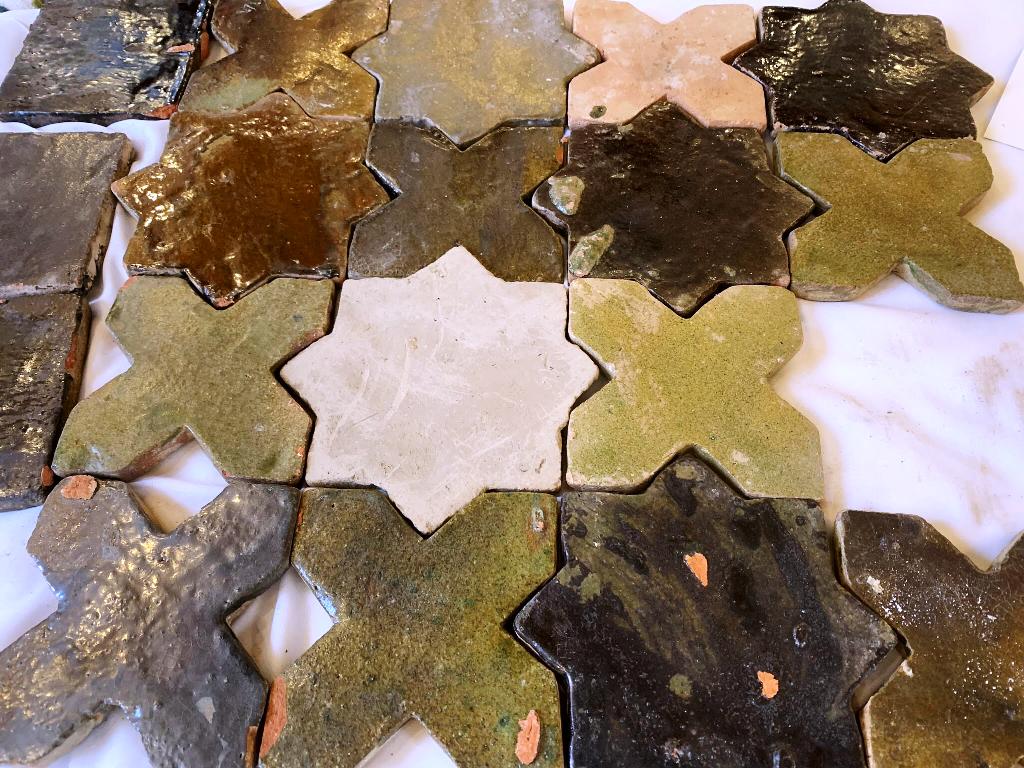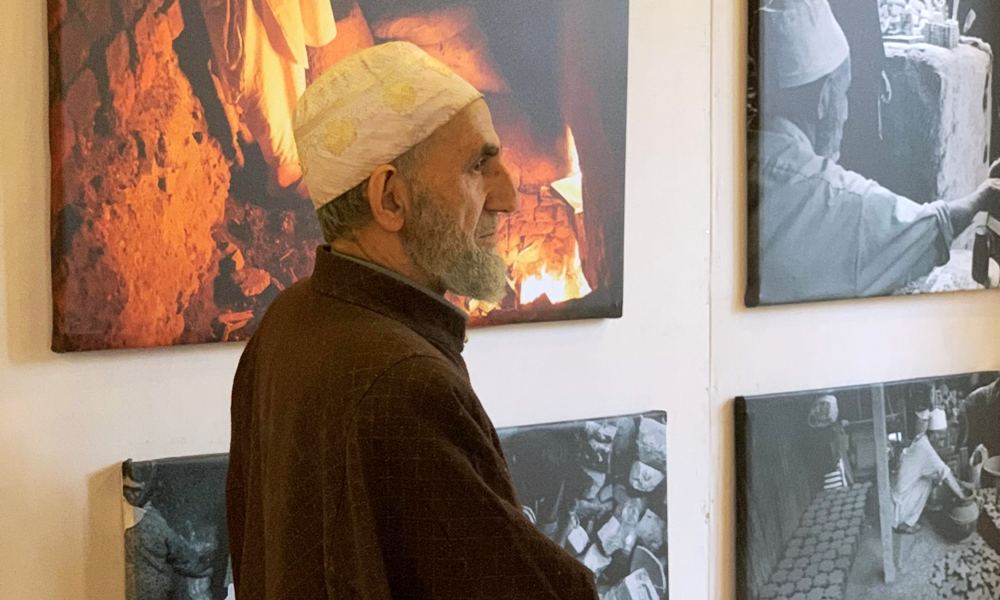After ruling Kashmir homes for decades, the Khanyar Rogni tiles are so low in demand that now only two artisans are associated with the art. With bright finished tiles filling the billion rupee sector, Syed Shadab Ali Gillani meets stakeholders to offer ideas for reviving the heritage craft
Nestled in the cultural milieu of Khanyar, the heart of Shehr-e-Kashmir, Srinagar lives the region’s last surviving traditional clay tile maker. Aged, he still uses the traditional practices for colouring these tiles, once a fashion statement.
These tiles, popularly known as Roghni or Khanyari tiles, were famous for their fine craftsmanship and distinctive designs for more than a century. Now Haji Ghulam Mohammad Kumhar, 75, is the lone artisan to carry forward this heritage.
Kumhar inherited the craft from his father and grandfather. “I started learning the craft of Roghni tile making at the age of 15 and have been in this profession for around 60 years,” he said.
With his expertise in clay tile-making and the unique art of colouring them, Kumhar has been able to keep the legacy alive. He remembers the days when these tiles were part of every household. Although “various challenges of modern times” have pushed the tiles out of fashion, Kumhar boasts that “one can still find these tiles in some buildings and shrines.”

Out of Fashion
“Tile making was practised throughout Kashmir and Khanyar was full of tile makers like me but now these tiles are on the verge of extinction,” Kumhar regretted as these tiles, considered an ‘essential part of exquisite Kashmiri architecture depicting Kashmir’s rich craftsmanship, are no more in vogue.
There are two major challenges. Firstly, these tiles have been unable to compete with tiles being imported from outside. Secondly, there has not been any mechanical intervention in the craft that could have helped the tile compete better. Finally, when the market dried up, the younger generation of craftsmen showed little interest in carrying forward the craft.
Javed Ahmed, Kumhar’s elder son, said these tiles are not valued in the market. “I belong to a family which has a lineage of tile makers but nowadays one can’t earn a livelihood from this business,” he said. “Looking at the present market conditions and declining demand,” he finds it challenging to survive.
Fall In Demand
Nowadays orders for these tiles have consistently been going down. “Earlier there were many makers and every day we all had orders of around 50000 tiles, but with the decline in demand, I am the only one involved with this art in Khanyar,” Kumhar said. “Considering my health conditions, I can barely produce about 100 tiles.”
Saleem Beigh, the head of INTACH Kashmir admitted the ‘demand is the problem’. “These tiles were typically utilised in sitting areas in houses, but their use was adversely affected by the introduction of new types of flooring and tiles in the market,” he said. “We need to work on the demand side. The use of these tiles in public areas, such as government buildings, public spaces and shrines, will attract more people to these crafts and create a good demand.”

Skill Transfer
Kumhar Sr, however, is undeterred. Market demand apart, he takes great pride in his work and is committed to preserving this age-old tradition. He hopes that someone will continue the legacy, but understands that it may be an uphill task.
His focus, right now, is to inherit the skill. “I want to teach this craft to more and more people so that this art form which has a deep cultural significance lasts long,” he said. “But I don’t have enough space in my workshop. Many people visit here to learn this art form but due to lack of space I am not able to teach them, which is very unfortunate and disheartening.”
Off late, Kumhar has taught a new generation potter Mohammad Umer this craft. Seemingly, this is Kumhar’s major achievement. “My family has been in the pottery business and although many potters are capable of creating these handmade clay tiles, only Haji Sahab is the master of the craft of Roghan clays,” Umar said. “I spent over three years learning this art form from him, and my training is still going on.”
Umer admires Haji’s patience with which he makes these tiles as these are delicate. “A single error might completely wreck the whole process,” he said. Given the fact that these tiles are made manually, more people are required to pick the skill. “After learning this craft from Haji Sahab, I also taught this craft to my brother and now we have set up a small workspace at our residence in Nishat, where presently we are teaching this craft to few others.”
Laborious Exercise
Khanyari tile making is laborious and labour intensive because the entire process is manual. “It begins with the selection of high-quality clay, which is then moulded into intricate designs using traditional tools, then to colour these tiles different materials including copper dust, iron dust, lead are used,” Kumhar said. “It is followed by drying of these tiles at high temperatures in a traditional kiln, which provides them with their unique strength, texture and durability.”
In a world where mass-produced products have become the norm, the Khanyari tile makers stand out as a reminiscence of the beauty and value of Kashmir’s heritage craftsmanship. Kumhar’s dedication to keeping the craft alive led him to knock at many doors in the last few years. Some officers made promises to him at an exhibition last year.
“They told me that I will be provided with a piece of land so that I can set up my workshop and teach people, but till now I do not have any information about that,” Kumhar regretted. Umer said they were told that the file was being processed but later we did not hear anything.
Recently, Umar said he got an order of around 4000 tiles. “It will take me around a month or more because all the work is done manually,” Umar said, insisting these orders are less frequent.
A Way Out
Beigh, who earlier headed the handicrafts and the industries department and is aware of the socio-cultural worth of Kashmir, said mere demand, will not help. “I believe people are ready to pay a good price for good quality things,” Beigh said, suggesting the tile’s up-gradation as a piece of art. “Art is valued a lot but it will only happen if we consider the artistic way. The artistic approach can be used by starting studios. We need to do things out of the box, by using these skills to create different things. We have to take risks to create demand among people. The usage should be in modern medium, artists need to step in and when an artist becomes part of architecture and they will create space for these tiles.”
In November 2022, a Kashmir-based architect and professional city planner, Zoya Khan did an exhibition, The Last Craftsman, which was supported by the Department of handicrafts and Handloom. It was aimed at creating awareness and educating people about this dying art form.
“Three years ago, I actually wanted these tiles for a project and that is when I discovered that these tiles are almost on the verge of extinction,” Zoya said. “These tiles were once very popular, people associated with this craft used to get about 3000 tiles made at its peak in the Mohalla and now years passed and these people don’t have any orders.”
Revival Possible
This art is part of the heritage and is deep-rooted in Kashmir’s architectural history. “This profession plays a significant role in our tangible cultural legacy. Therefore, it should be preserved, and I find it fascinating that Haji Sahab, who works in a single small Karkhana in the city, does not, unfortunately, receive the love and care he so richly deserves. I want more and more people to become involved in this and become informed about how this craft is in jeopardy of disappearing entirely if we don’t take action soon,” Zoya stated
Beigh regretted that Kashmir society has failed in popularising its own art. “Even if times have changed, there are still places where many artistic things can be used, and these tiles are one of those,” he suggested. “While the process will take some time, once a trend emerges, more people will become involved. The government could also put up a small industrial area for a number of small businesses that would house these craftspeople.” Beigh admitted that the government must serve as both a consumer and a facilitator to revive this art and make it mainstream.












